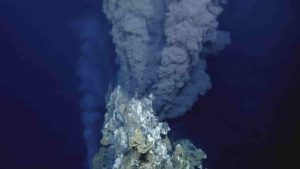
What Is a Hydrothermal Vent?
A hydrothermal vent is a fissure on the seafloor from which geothermally heated water issues. Hydrothermal vents are commonly found near volcanically active places, areas where tectonic plates are moving apart at spreading centers, ocean basins, and hotspots. Hydrothermal deposits are rocks and mineral ore deposits formed by the action of hydrothermal vents.
Hydrothermal vents exist because the earth is both geologically active and has large amounts of water on its surface and within its crust. Under the sea, hydrothermal vents may form features called black smokers or white smokers. Relative to the majority of the deep sea, the areas around submarine hydrothermal vents are biologically more productive, often hosting complex communities fueled by the chemicals dissolved in the vent fluids.
Chemosynthetic bacteria and archaea form the base of the food chain, supporting diverse organisms, including giant tube worms, clams, limpets and shrimp. Active hydrothermal vents are believed to exist on Jupiter’s moon Europa, and Saturn’s moon Enceladus, and it is speculated that ancient hydrothermal vents once existed on Mars.
How Do Hydrothermal Vents Occur?
Hydrothermal vents are the result of seawater percolating down through fissures in the ocean crust in the vicinity of spreading centers or subduction zones (places on Earth where two tectonic plates move away or towards one another). The cold seawater is heated by hot magma and reemerges to form the vents.
Why Are Hydrothermal Vents Black?
A venting black smoker emits jets of particle-laden fluids. The particles are predominantly very fine-grained sulfide minerals formed when the hot hydrothermal fluids mix with near-freezing seawater. These minerals solidify as they cool, forming chimney-like structures. “Black smokers” are chimneys formed from deposits of iron sulfide, which is black. “White smokers” are chimneys formed from deposits of barium, calcium, and silicon, which are white.
Underwater volcanoes at spreading ridges and convergent plate boundaries produce hot springs known as hydrothermal vents.
What Are Black smokers and white smokers?
Black smokers Vent
A black smoker or deep sea vent is a type of hydrothermal vent found on the seabed, typically in the bathyal zone (with largest frequency in depths from 2500 m to 3000 m), but also in lesser depths as well as deeper in abyssal zone. They appear as black, chimney-like structures that emit a cloud of black material. Black smokers typically emit particles with high levels of sulfur-bearing minerals, or sulfides. Black smokers are formed in fields hundreds of meters wide when superheated water from below Earth’s crust comes through the ocean floor (water may attain temperatures above 400 °C).
Black smokers were first discovered in 1979 on the East Pacific Rise by scientists from Scripps Institution of Oceanography. They were observed using the deep submergence vehicle ALVIN from the Woods Hole Oceanographic Institution. Now, black smokers are known to exist in the Atlantic and Pacific Oceans, at an average depth of 2100 metres.
The most northerly black smokers are a cluster of five named Loki’s Castle, discovered in 2008 by scientists from the University of Bergen at 73°N, on the Mid-Atlantic Ridge between Greenland and Norway. These black smokers are of interest as they are in a more stable area of the Earth’s crust, where tectonic forces are less and consequently fields of hydrothermal vents are less common. The world’s deepest known black smokers are located in the Cayman Trough, 5,000 m (3.1 miles) below the ocean’s surface.
White smoker vents
White smoker vents emit lighter-hued minerals, such as those containing barium, calcium and silicon. These vents also tend to have lower-temperature plumes probably because they are generally distant from their heat source.
Black and white smokers may coexist in the same hydrothermal field, but they generally represent proximal and distal vents to the main upflow zone, respectively. However, white smokers correspond mostly to waning stages of such hydrothermal fields, as magmatic heat sources become progressively more distant from the source (due to magma crystallization) and hydrothermal fluids become dominated by seawater instead of magmatic water. Mineralizing fluids from this type of vents are rich in calcium and they form dominantly sulfate-rich (i.e., barite and anhydrite) and carbonate deposits.
Where Are Hydrothermal Vents Located?
Like hot springs and geysers on land, hydrothermal vents form in volcanically active areas—often on mid-ocean ridges, where Earth’s tectonic plates are spreading apart and where magma wells up to the surface or close beneath the seafloor.










